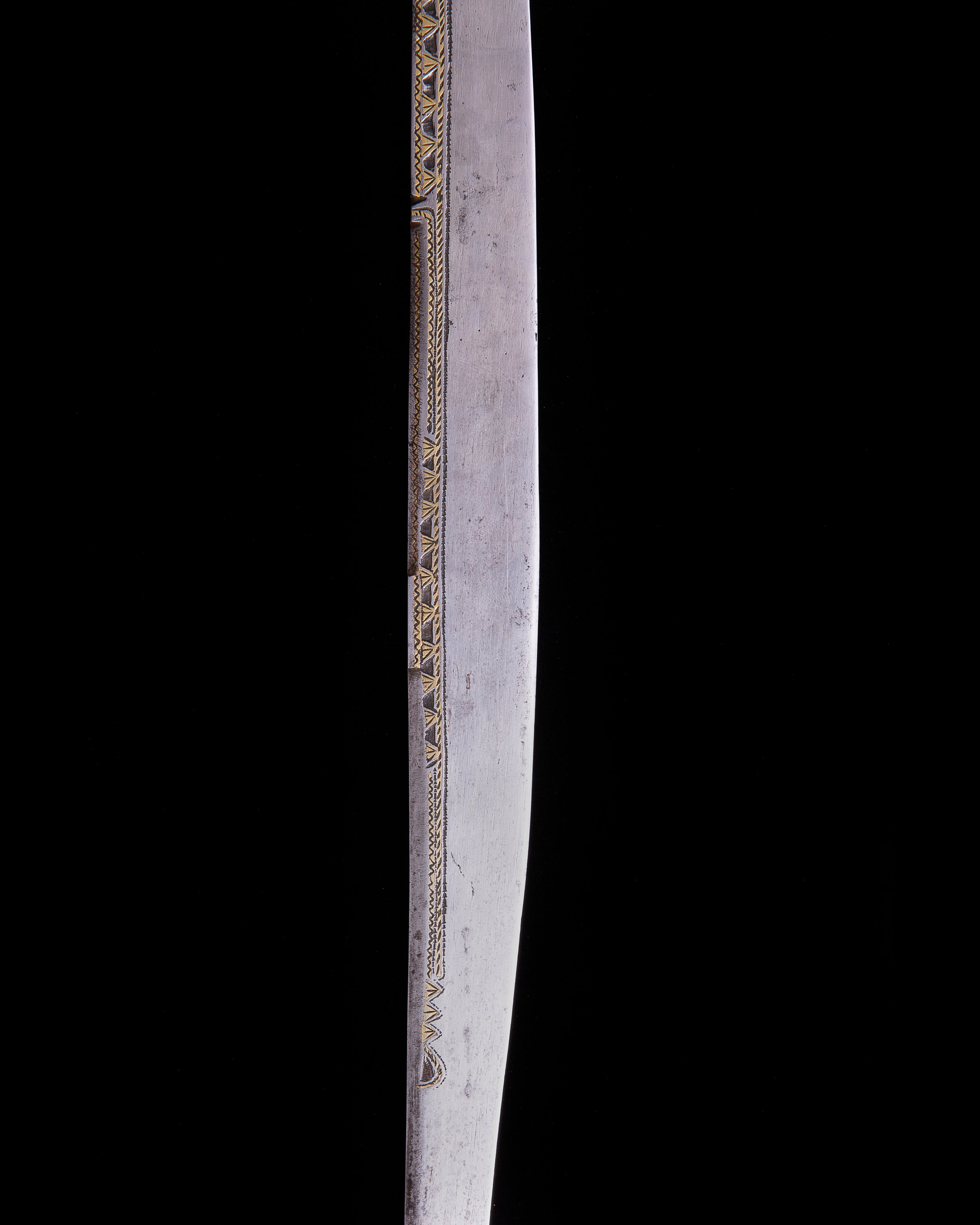Large North African Flyssa
The national sword of the Kaybles, a group of Berber tribes from Algeria. The steel and brass hilt is decorated with repoussé and chasing and has a characteristic stylized animal head pommel. The blade is decorated with brass inlay and elaborate symbolism in the form of amuletic geometric figures are engraved along most of the back edge and spine
The blade is 99cm long with an 11cm handle. In overall excellent condition, minor areas of marking and use to the blade and the handle.
Dating from the 19th century, the name “Flyssa” derives from a French transliteration referring to the “Iflissen Lebhar”, one of the major tribal confederations of the Kabyle. Unlike many North African swords, which are fitted with European blades, the flyssa blade is without exception of local manufacture. The oldest flyssa with good provenance is in the French Foreign Legion museum in France, captured in battle with Kabyles in 1857. Emir Abdelkader also references one in a poem, describing how he cut a French soldier nearly in half with it
As well as the blade shape, the species of animal depicted on the flissa hilts has also created much academic speculation. What is important about these figures is that their eyes are always exaggerated in size. The decoration on the sword serving to protect the wielder against the Evil Eye. The Evil Eye is a major concern for Berber and Islamic North Africans alike. Decoration is applied to many manufactured objects in the region, with which one can repel, pierce or deflect the Evil Eye. The individual triangular motifs on the back of this sword's blade represent clothes pins (fibulae), which are understood to pierce the Evil Eye, while the zigzag line motifs represent a snake, which then drives it away. The glare from one eye is believed to repel that of another so the animal-headed pommel has been cast here with large eyes.
The national sword of the Kaybles, a group of Berber tribes from Algeria. The steel and brass hilt is decorated with repoussé and chasing and has a characteristic stylized animal head pommel. The blade is decorated with brass inlay and elaborate symbolism in the form of amuletic geometric figures are engraved along most of the back edge and spine
The blade is 99cm long with an 11cm handle. In overall excellent condition, minor areas of marking and use to the blade and the handle.
Dating from the 19th century, the name “Flyssa” derives from a French transliteration referring to the “Iflissen Lebhar”, one of the major tribal confederations of the Kabyle. Unlike many North African swords, which are fitted with European blades, the flyssa blade is without exception of local manufacture. The oldest flyssa with good provenance is in the French Foreign Legion museum in France, captured in battle with Kabyles in 1857. Emir Abdelkader also references one in a poem, describing how he cut a French soldier nearly in half with it
As well as the blade shape, the species of animal depicted on the flissa hilts has also created much academic speculation. What is important about these figures is that their eyes are always exaggerated in size. The decoration on the sword serving to protect the wielder against the Evil Eye. The Evil Eye is a major concern for Berber and Islamic North Africans alike. Decoration is applied to many manufactured objects in the region, with which one can repel, pierce or deflect the Evil Eye. The individual triangular motifs on the back of this sword's blade represent clothes pins (fibulae), which are understood to pierce the Evil Eye, while the zigzag line motifs represent a snake, which then drives it away. The glare from one eye is believed to repel that of another so the animal-headed pommel has been cast here with large eyes.
The national sword of the Kaybles, a group of Berber tribes from Algeria. The steel and brass hilt is decorated with repoussé and chasing and has a characteristic stylized animal head pommel. The blade is decorated with brass inlay and elaborate symbolism in the form of amuletic geometric figures are engraved along most of the back edge and spine
The blade is 99cm long with an 11cm handle. In overall excellent condition, minor areas of marking and use to the blade and the handle.
Dating from the 19th century, the name “Flyssa” derives from a French transliteration referring to the “Iflissen Lebhar”, one of the major tribal confederations of the Kabyle. Unlike many North African swords, which are fitted with European blades, the flyssa blade is without exception of local manufacture. The oldest flyssa with good provenance is in the French Foreign Legion museum in France, captured in battle with Kabyles in 1857. Emir Abdelkader also references one in a poem, describing how he cut a French soldier nearly in half with it
As well as the blade shape, the species of animal depicted on the flissa hilts has also created much academic speculation. What is important about these figures is that their eyes are always exaggerated in size. The decoration on the sword serving to protect the wielder against the Evil Eye. The Evil Eye is a major concern for Berber and Islamic North Africans alike. Decoration is applied to many manufactured objects in the region, with which one can repel, pierce or deflect the Evil Eye. The individual triangular motifs on the back of this sword's blade represent clothes pins (fibulae), which are understood to pierce the Evil Eye, while the zigzag line motifs represent a snake, which then drives it away. The glare from one eye is believed to repel that of another so the animal-headed pommel has been cast here with large eyes.











